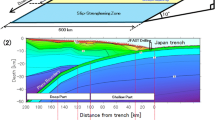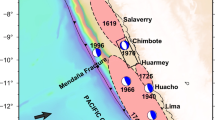Abstract
An M8.3 earthquake struck the southwestern part of the Hellenic Arc, near the Island of Crete, in AD 365, generating a tsunami that affected almost the entire eastern Mediterranean region. Taking into account that the time history of seismicity in this region is fairly complete for such earthquakes in the historical catalog, which can be dated as back as the 5th century B.C., there is no indication that this segment of plate boundary has been fully ruptured again. The seismic hazard associated with this part of the Hellenic Arc necessitates the evaluation of the rupture characteristics of this great event. The constraint of the faulting geometry was initially achieved by using information from seismicity, and the focal mechanisms of earthquakes that occurred during the instrumental period. A rupture model for this great earthquake is constructed by assuming an elastic medium and calculating the theoretical surface displacements for various fault models that are matched with the observed surface deformation gleaned from historical reports. The resulted fault model concerns thrust faulting with a rupture length of 160 km and a seismic moment of 5.7 × 1028 dyn·cm, an average slip of 8.9 m and a corresponding moment magnitude equal to 8.4, in excellent agreement with the macroseismic estimation. The absence of such events recurrence is an indication of the lack of complete seismic coupling that is common in subduction zones, which is in accordance with the back arc spreading of the Aegean microplate and with previous results showing low coupling for extensional strain of the upper plate.
Similar content being viewed by others
References
Ambraseys, N., C. Melville, and R. Adams (1994), The Seismicity of Egypt, Arabia and the Red Sea, Cambridge University Press, Cambridge.
Ando, M. (1975), Source mechanisms and tectonic significance of historical earthquakes along the Nankai trough, Japan, Tectonophysics 27, 119–140.
Angelier, J. (1979), Recent quaternary tectonics in the Hellenic arc: Examples of geological observations on land, Tectonophysics 52, 267–275.
Angelier, J., N. Lyberis, X. LePichon, and X. Huchon (1982). The tectonic development of the Hellenic arc and the Sea of Crete: A synthesis, Tectonophysics 86, 159–196.
Argus, D.F., R.G. Gordon, C. DeMets, and S. Stein (1989), Closure of the Africa-Eurasia-North America plate motion circuit and tectonics of the Gloria fault, J. Geophys. Res. 94, 5585–5602.
Baker, C., D. Hatzfeld, H. Lyon-Caen, E. Papadimitriou, and A. Rigo (1997), Earthquake mechanisms of the Adriatic Sea and western Greece: implications for the oceanic sudbuction — continental collision transition, Geophys. J. Intern. 131, 559–594.
Benetatos, C., A. Kiratzi, C. Papazachos, and G. Karakaisis (2004), Focal mechanisms of shallow and intermediate depth earthquakes along the Hellenic Arc, J. Geodyn. 37, 253–296.
Casten, U., and K. Snopek (2006), Gravity modeling of the Hellenic subduction zone — a regional study, Tectonophysics 417, 183–200.
Erikson, L. (1986), A three-dimensional dislocation program with applications to faulting in the Earth, Masters Thesis, Stanford Univ., Stanford, CA, 167 pp.
Flemming, N.C., and P.A. Pirazzoli (1981), Archéologie des côtes de la Crète, Histoire et Archéologie, Dossiers 50, 66–81.
Fytikas, M., F. Innocenti, P. Manetti, R. Mazzuoli, A. Peccerilo, and L. Villari (1984) Tertiary to Quaternary evolution of volcanism in the Aegean region, Geol. Soc. London, Spec. Publ. 17, 687–699.
Govers, R., and M.J.R. Wortel (2005), Lithosphere tearing at STEP faults: Response to edges of subduction zones, Earth Planet. Sci. Lett. 236, 505–523.
Guidoboni, E., A. Comastri, and G. Traina (1994), Catalogue of Ancient Earthquakes in the Mediterranean Area up to 10 th Century, Istituto Nazionale di Geofisica, Roma, 504 pp.
Hatzfeld, D., G. Pedottti, P. Hatzidimitriou, and K. Makropoulos (1990), The strain pattern in the western Hellenic arc deduced from a microearthquake survey. Geophys. J. Int. 101, 181–202.
Jackson, J. (1994), Active tectonics of the Aegean region, Annu. Rev. Earth Planet. Sci. 22, 239–271.
Jarrard, R.D. (1986), Causes of compression and extension behind trenches, Tectonophysics 132, 89–102.
Kanamori, H. (1977), The energy release in great earthquakes, J. Geophys. Res. 82, 2981–2987.
Kanamori, H. (1986), Rupture process of subduction zone earthquakes, Ann. Rev. Earth Planet. Sci. 14, 293–322.
Kastens, K.A. (1991), Rate of outward growth of the Mediterranean Ridge accretionary complex: volume balance of mud extrusion versus subduction-accretion, Tectonophysics 199, 25–50.
Kiratzi, A.A., and C. Langston (1989), Estimation of earthquake source parameters of the May 4, 1972 event of the Hellenic arc by the inversion of waveform data, Phys. Earth Planet. Inter. 57, 225–232.
Kiratzi, A.A., and C.B. Papazachos (1995), Active seismic deformation in the southern Aegean Benioff zone, J. Geodynamics 19, 65–78.
Laborel, J., and F. Laborel-Deguen (1994), Biological indicators of Holocene sea-level variations and of co-seismic displacement in the Mediterranean area, J. Coast. Res. 10, 395–415.
LePichon, X., and J. Angelier (1979). The Hellenic arc and trench system: A key to the neotectonic evolution of the eastern Mediterranean area, Tectonophysics 60, 1–42.
LePichon, X., and J. Angelier (1981), The Aegean Sea, Phil. Trans. Roy. Soc. London 300, 357–372.
Li, X., G. Bock, A. Vafidis, R. Kind, H.-P. Harjes, W. Hanka, K. Wylegalla, M. van der Meijde, and X. Yuan (2003), Receiver function study of the Hellenic subduction zone: imaging crustal thickness variations and the oceanic Moho of the descending African lithosphere, Geophys. J. Intern. 155, 733–748.
Louvari, E. (2000), A detailed seismotectonic study in the Aegean Sea and the surrounding area with emphasis on the information obtained from microearthquakes, Ph.D. Thesis, Aristotle University of Thessaloniki, 373 pp.
Lyon-Caen, H., R. Armijo, J. Drakopoulos, J. Baskoutas, N. Delibasis, R. Gaulon, V. Kouskouna, J. Latoussakis, K. Makropoulos, P. Papadimitriou, D. Papanastasiou, and G. Pedotti (1988), The 1986 Kalamata (south Peloponnesus) earthquake: Detailed study of a normal fault for east-west extension in the Hellenic arc, J. Geophys. Res. 93, 14967–15000.
Mascle, J., and E. Chaumillon (1997), Pre-collisional geodynamics of the Mediterranean Sea: The Mediterranean Ridge and the Tyrrhenian Sea, Annali Geofis. 40, 569–586.
McKenzie, D. (1978), Active tectonics of the Alpine-Himalayan belt: The Aegean Sea and surrounding regions, Geophys. J. Roy. Astron. Soc. 55, 217–254.
Meijer, P.T., and M.J.R. Wortel (1996), Temporal variations in the stress field of the Aegean region, Geophys. Res. Lett. 23, 439–442.
Okada, Y. (1992), Internal deformation due to shear and tensile faults in a half-space, Bull. Seismol. Soc. Am. 82, 1018–1040.
Olivet, J.-L., J. Bonnin, P. Beuzart, and J.M. Auzende (1982), Cinématique des plaques et paléogéographie: une revue, Bull. Soc. Géol. France 24, 875–892.
Pacheco, J.F., L.R. Sykes, and C.H. Scholz (1993), Nature of seismic coupling along simple plate boundaries of the subduction type, J. Geophys. Res. 98, 14,133–14,159.
Papadimitriou, E. (1993), Focal mechanism along the convex side of the Hellenic Arc, Boll. Geof. Teor. Appl. 35, 401–426.
Papazachos, C.B. (1992), Anisotropic radiation modelling of macroseismic intensities for estimation of the attenuation structure of the upper crust in Greece, Pure Appl. Geophys. 138, 445–469.
Papazachos, B.C. (1996), Large seismic faults in the Hellenic Arc, Annali Geof. 39, 891–903.
Papazachos, B.C., and P.E. Comninakis (1971), Geophysical and tectonic features of the Aegean Arc, J. Geophys. Res. 76, 8517–8533.
Papazachos, C.B., and G. Nolet (1997), P and S deep velocity structure of the Hellenic Arc obtained by robust nonlinear inversion of travel times, J. Geophys. Res. 102, 8349–8367.
Papazachos, C.B., and Ch.A. Papaioannou (1997), The macroseismic field in the Balkan area, J. Seismology 1, 181–201.
Papazachos, B.C., and C. Papazachou (2003), The Earthquakes of Greece, Ziti Publ., Thessaloniki, 317 pp.
Papazachos, B.C., A.A. Kiratzi, and V.G. Karakostas (1997a). Toward a homogeneous moment magnitude determination in Greece and surrounding area, Bull. Seism. Soc. Am. 87, 474–483.
Papazachos, B.C., Ch.A. Papaioannou, C.B. Papazachos, and A.S. Savvaidis (1997b), Atlas of isoseismal maps for strong earthquakes in Greece and surrounding area (426 BC-1995), Publ. Geophys. Lab., Univ. Thessaloniki 4, 192 pp.
Papazachos, B.C., B.G. Karakostas, C.B. Papazachos, and E.M. Scordilis (2000), The geometry of the Benioff zone and lithospheric kinematics in the Hellenic Arc, Tectonophysics 319, 275–300.
Papazachos, B.C., D.M. Mountrakis, C.B. Papazachos, M.D. Tranos, G.F. Karakaisis, and A.S. Savvaidis (2001), The faults that caused the known strong earthquakes in Greece and surrounding areas during 5th century B.C. up to present, 2 nd Conf. Earthq. Enging. and Engin. Seism., 28–30 September 2001, Thessaloniki 1, 17–26.
Papazachos, B.C., E.M. Scordilis, D.G. Panagiotopoulos, C.B. Papazachos, and G.F. Karakaisis (2004), Global relations between seismic fault parameters and moment magnitude of earthquakes, 10 th Congr. Hellenic Geol. Society, 14–17 April 2004, Thessaloniki, 539–540.
Pirazzoli, P.A. (1996), Sea-level Changes. The Last 20,000 Years, Wiley, New York, 211 pp.
Pirazzoli, P.A. (1999), Les ports antiques soulevés de la Méditerranée orientale. In: V.M. Rosselló (ed.), Geoarqueologia I Quaternari Litoral, Valencia Univers. 391–401.
Pirazzoli, P.A., J. Thomeret, Y. Thomeret, J. Laborel, and L. Montagionni (1982), Crustal block movements from Holocene shorelines: Crete and Antikythira (Greece), Tectonophysics 68, 27–43.
Pirazzoli, P.A., J. Ausseil-Badie, P. Girese, E. Hadjidaki, and M. Arnold (1992), Historical environmental changes at Phalasarna Harbor, West Crete, Geoarchaeology 7, 371–392.
Pirazzoli, P.A., J. Laborel, and S.C. Stiros (1996), Earthquake clustering in the eastern Mediterranean during historical times, J. Geophys. Res. 101, 6083–6097.
Pologiorgi, M. (1985), Kisamos, the topography of an ancient town of western Crete, Archaeologika Analekta ex Athinon 18, 65–80 (in Greek).
Ruff, L., and H. Kanamori (1980), Seismicity and the subduction process, Phys. Earth Planet. Inter. 23, 240–252.
Satake, K. (1993). Depth distribution of coseismic slip along the Nankai trough, Japan, from joint inversion of geodetic and tsunami data, J. Geophys. Res. 98, 4553–4565.
Sato, T., and M. Matsu’ura (1988), A kinematic model for deformation of the lithosphere at subduction zones, J. Geophys. Res. 93, 6410–6418.
Sato, T., and M. Matsu’ura (1993), A kinematic model for evolution of island arc trench systems, Geophys. J. Int. 114, 512–530.
Scholz, C.H. (1982), Scaling laws for large earthquakes: Consequences for physical models, Bull. Seism. Soc. Am. 72, 1–14.
Scholz, C.H. (2002), The Mechanics of Earthquakes and Faulting, Cambridge University Press, Cambridge, 471 pp.
Scholz, C.H., and J. Campos (1995), On the mechanism of seismic decoupling and back arc spreading at subduction zones, J. Geophys. Res. 100, 22,103–22,115.
Scordilis, E.M., G.F. Karakaisis, B.G. Karakostas, D.G. Panagiotopoulos, P.E. Comninakis, and B.C. Papazachos (1985), Evidence for transform faulting in the Ionian Sea: The Cephalonia Island earthquake sequence, Pure Appl. Geophys. 123, 388–397.
Spakman, W., M.J.R. Wortel, and N.S. Vlaar (1988), The Hellenic subduction zone: a tomographic image and its geodynamic implications, Geophys. Res. Lett. 15, 60–63.
Steketee, J.A. (1958), On Voltera’s dislocations in a semi-infinite elastic medium, Can. J. Phys. 36, 192–205.
Stiros, S. (2001), The AD 365 Crete earthquake and possible seismic clustering during the fourth to sixth centuries AD in the Eastern Mediterranean: a review of historical and archaeological data, J. Struct. Geol. 23, 545–562.
Stiros, S.C., and S. Papageorgiou (2001), Seismicity of western Crete and the destruction of the town of Kissamos at AD 365: Archaeological evidence, J. Seismology 5, 381–397.
Taymaz, T., J. Jackson, and R. Westaway (1990), Earthquake mechanisms in the Hellenic trench near Crete, Geophys. J. Int. 102, 695–731.
Thommeret, Y., J. Laborel, L. Montaggioni, and P. Pirazzoli (1981), Late Holocene shoreline changes and seismotectonic displacements in western Greece (Greece), Z. Geomorph. Supl. 40, 127–149.
Uyeda, S., and H. Kanamori (1979), Back-arc opening and the mode of subduction, J. Geophys. Res. 84, 1049–1061.
Wessel, P., and W.H.F. Smith (1998), New, improved version of the Generic Mapping Tools Released, EOS Trans. AGU 79, 579.
Wortel, M.J.R., and W. Spakman (1992), Structure and dynamics of subducted lithosphere in the Mediterranean region, Proc. Kon. Ned. Acad. Sci. 95, 325–347.
Wortel, M.J.R., S.D.B Goes, and W. Spakman (1990), Structure and seismicity of the Aegean subduction zone, Terra Nova 2, 554–562.
Yabuki, T., and M. Matsu’ura (1992), Geodetic data inversion using a Bayesian information criterion for spatial distribution of fault slip, Geophys. J. Int. 109, 363–375.
Author information
Authors and Affiliations
Corresponding author
Rights and permissions
About this article
Cite this article
Papadimitriou, E.E., Karakostas, V.G. Rupture model of the great AD 365 Crete earthquake in the southwestern part of the Hellenic Arc. Acta Geophys. 56, 293–312 (2008). https://doi.org/10.2478/s11600-008-0001-6
Received:
Accepted:
Published:
Issue Date:
DOI: https://doi.org/10.2478/s11600-008-0001-6




